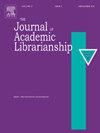Visual stimulation in virtual library environments for creative thinking: An integrated neurocognitive and psychological analysis
IF 2.3
3区 管理学
Q2 INFORMATION SCIENCE & LIBRARY SCIENCE
引用次数: 0
Abstract
This study examined how visual stimulation in virtual library environments affects creative thinking. Two virtual environments were designed: a C-space (supporting convergent thinking), featuring a simple layout with monochromatic tones and minimal materials, and a D-space (supporting divergent thinking), incorporating diverse finishes, irregular shapes, plants, and a high ceiling. Fifty-five Korean university students completed the Alternate Uses Task (AUT) and the Remote Associates Test (RAT) in both environments, while their brain activity was recorded via electroencephalography (EEG). Surveys measured psychological responses, including affective state and perceived restorativeness. Contrary to hypotheses, the visually simpler C-space facilitated both convergent and divergent thinking more effectively than the D-space. EEG results showed higher frontal theta, alpha, and gamma activity during AUT in the C-space, indicating greater cognitive engagement and internally oriented attention. During RAT, decreased parieto-occipital alpha power and increased gamma power suggested enhanced mental imagery for problem-solving. Although students perceived the D-space as emotionally positive, its visual complexity appeared to hinder sustained attention. These findings align with cognitive load theory, highlighting that reduced visual complexity supports creative cognition by minimizing distractions. While further validation in real-world settings is needed, this study offers preliminary insights for optimizing library design to enhance creativity.
虚拟图书馆环境中的视觉刺激对创造性思维的影响:一种综合的神经认知和心理分析
本研究考察了虚拟图书馆环境中的视觉刺激如何影响创造性思维。设计了两个虚拟环境:一个是c空间(支持收敛性思维),以单色色调和最小材料的简单布局为特色;一个是d空间(支持发散性思维),结合了不同的饰面、不规则的形状、植物和高高的天花板。55名韩国大学生在两种环境下完成了交替使用任务(AUT)和远程联想测试(RAT),并通过脑电图(EEG)记录了他们的大脑活动。调查测量了心理反应,包括情感状态和感知恢复。与假设相反,视觉上更简单的c空间比d空间更有效地促进了收敛和发散思维。脑电图结果显示,在AUT期间,c空间的额叶θ、α和γ活动较高,表明认知参与和内定向注意程度较高。在大鼠实验中,顶叶-枕叶α能量的下降和γ能量的增加表明解决问题的心理意象增强。尽管学生们认为d空间在情感上是积极的,但其视觉复杂性似乎阻碍了持续的注意力。这些发现与认知负荷理论一致,强调减少视觉复杂性通过减少干扰来支持创造性认知。虽然需要在现实环境中进一步验证,但本研究为优化图书馆设计以增强创造力提供了初步的见解。
本文章由计算机程序翻译,如有差异,请以英文原文为准。
求助全文
约1分钟内获得全文
求助全文
来源期刊

Journal of Academic Librarianship
INFORMATION SCIENCE & LIBRARY SCIENCE-
CiteScore
5.30
自引率
15.40%
发文量
120
审稿时长
29 days
期刊介绍:
The Journal of Academic Librarianship, an international and refereed journal, publishes articles that focus on problems and issues germane to college and university libraries. JAL provides a forum for authors to present research findings and, where applicable, their practical applications and significance; analyze policies, practices, issues, and trends; speculate about the future of academic librarianship; present analytical bibliographic essays and philosophical treatises. JAL also brings to the attention of its readers information about hundreds of new and recently published books in library and information science, management, scholarly communication, and higher education. JAL, in addition, covers management and discipline-based software and information policy developments.
 求助内容:
求助内容: 应助结果提醒方式:
应助结果提醒方式:


